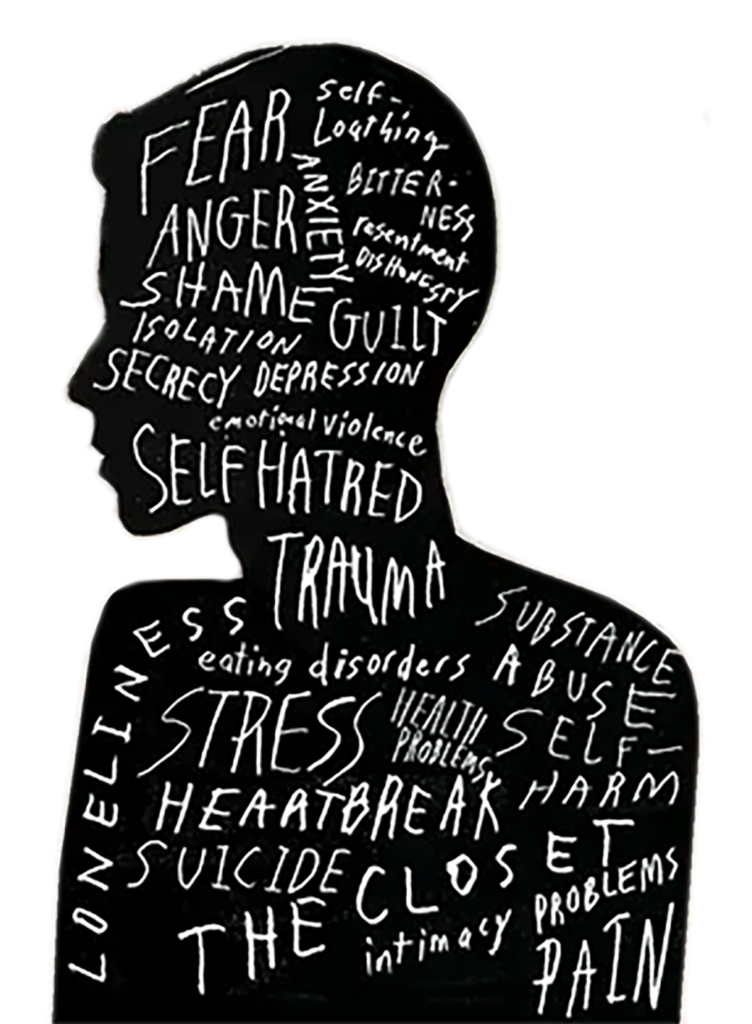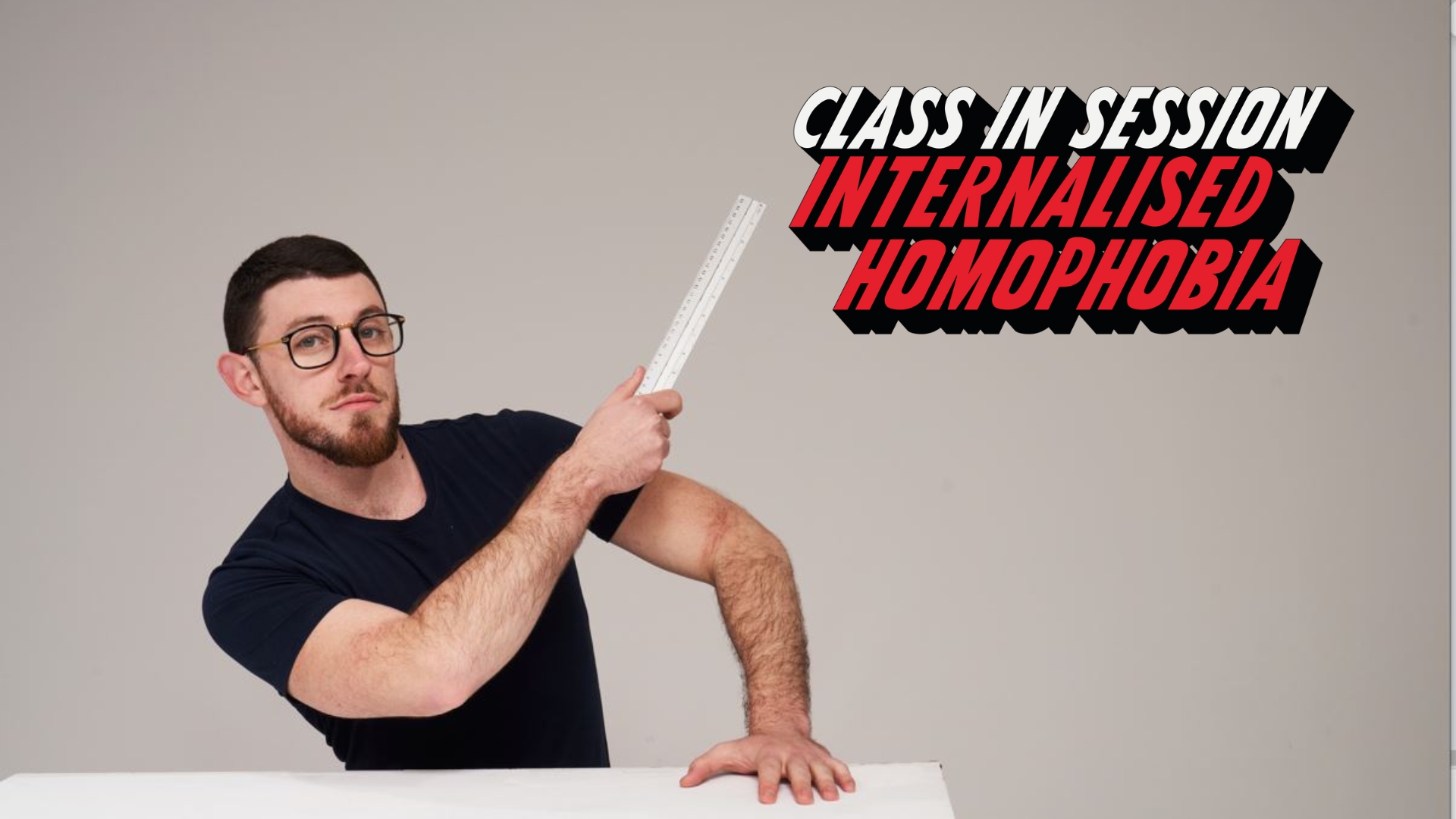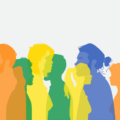In last issue’s Class in Session, we learnt all about the troublesome phenomenon of bottom shaming. Unfortunately, however, bottom shaming is far from being the only topic on which we could all do with a little more education. There is plenty more room for us to grow as a community. So, with that said, WINGS is back in the teacher’s seat once again. The theme of this class: Internalised Homophobia. Crack out those notepads and pens because class is officially back in session.
Let’s start with a definition. It is of the utmost importance to note already that this is simply “a definition”. For decades, scholars, therapists and LGBTQ+ activists alike have all strived to settle on “the definition”, to no avail. Perhaps something as nuanced and intricate as internalised homophobia refuses to be confined to a single dictionary entry. However, we must begin somewhere: “Internalised homophobia is defined as the self-hatred and shame of homosexually oriented individuals that has been incorporated into their belief system”. Now, if I ask for a show of hands if you understand that definition, I will likely see that most of you do. But, if I ask for a show of hands if you can relate to internalised homophobia, I venture to bet that most of you will keep your hands down. That is an issue, because as you are about to learn, internalised homophobia affects many more of us in the LGBTQ+ community than we might like to admit. And the reason for that, all starts with the problematic and misleading terminology itself.

Let’s break it down, starting with ‘internalised’. As one researcher on the topic points out: “The concept suggests weakness rather than the resilience demonstrated by lesbians and gay men and keeps the focus away from the structures of inequality and oppression”. So instead of recognising that homophobia, be it externalised or internalised, is a result of growing up in a society that normalises heterosexuality and marginalises (or at worst demonises) any sexual orientation that diverges from that norm, the word ‘internalised’ makes it sound like we are to blame.
Then there’s the word ‘homophobia’. The American Psychological Association defines the term homophobia as “dread or fear of gay men and lesbians, associated with prejudice and anger toward them ”. Here we face the second hurdle. The word homophobia and the definition attached to it, seems to be somewhat of an oxymoron. How can queer-identifying people dread, be fearful, have prejudice or be angry towards themselves? This idea becomes even more alien and absurd for those of us who are out of the closet and ‘proudly’ living the queer existence.
“I completely lost my identity in the process of trying to cover up certain personality traits and trying to compensate in other ways, to fit the societal role of the ‘ideal man’.”
Koosha Nouri in TEDx Talks
Hopefully it is becoming apparent, and admissible, why so many LGBTQ+ folk fervently deny harbouring any internalised homophobia. The terminology is so inapt in fact that some researchers have proposed that adding the terms heterosexism, internalised sexual-prejudice and internalised sexual-stigma to our canon of vocabulary will add necessary depth to our understanding. So, proceeding with caution and an awareness that internalised homophobia is not a trait that is solely internal to the person, let’s begin to strip away the terminology and perhaps turn our focus towards the ways in which we can identify internalised homophobia. Only then might we begin to realise, and perhaps accept, that we may not be as untouched by it as we originally thought.
“What is an effeminate man? What is that about? You know, what does that entail? Is that what I’m to become? And I was just fascinated and repulsed by it. It’s so hard to explain, and what it is, it’s just internal homophobia. It’s what every gay man on the planet has dealt with and that is this internal thing that we were raised with.”
Leslie Jordan in The Originals (podcast)
In 1996, two psychologists, Ross and Rosser, developed a scale to measure internalised homophobia. Whilst this is not the only scale developed, and one that is admittedly becoming outdated, it does a good job at showing how varied, in terms of severity, internalised homophobia is. The researchers identified four dimensions of the condition: a queer persons’ public identification, their social comfort with other LGBTQ+ people, their perception of the stigma around their sexuality, and their moral or religious beliefs about it. Based on their scale, I have curated the following list of modernised and hopefully more relatable statements. Read each one carefully, and ask yourself, honestly, to what degree you agree.
- Overtly queer people make me feel uncomfortable
- I get embarrassed when I think of another queer person ‘representing me’
- I understand why some straight people think negatively about homosexuality
- I don’t object when I hear an anti-gay jokes. Sometimes I even make them
- I feel uncomfortable in gay bars and clubs, or in the community in general
- I prefer to have anonymous sexual partners
- As a queer person, I worry about growing old
- If I could change my sexual orientation, I probably would
If I were to hear you say, “But teacher, all this sounds quite clinical!”, you’d be right. Whilst scales like this serve us on a preliminary level, it’s important to look beyond the discoveries of psychologists, and realise that whether you experience internalised homophobia is a question best answered by yourself. Then the question becomes, “OK fine, maybe I do have a little internalised homophobia, but what’s the issue?” Internalised homophobia manifests itself in a multitude of ways – which is just a fancy way of saying that there are several reasons why we should care.
“I couldn’t talk to anyone about it. I had a lot of internalised homophobia and shame. I thought I was abnormal. I thought about ending my life, and I’m so glad I didn’t…”
Cara Delevigne in Planet Sex (documentary)
Firstly, internalised homophobia can get you stuck in a cycle of secrecy and dishonesty. This ranges from denying yourself of the life you want or deserve, lying to yourself about attraction, forcing others to keep secrets, to the inability to come out (if you want to come out, and if you can do so safely!). Internalised homophobia can also have a severe impact on your interpersonal relationships and sexual encounters. It could be the thing preventing you from being emotionally intimate with someone. It could be causing your low self-esteem which then begins to deteriorate your relationship with loved ones. It could lead to isolation and loneliness. Or to feeling ashamed and unsatisfied by sexual experiences; leaving you dependent on drugs or alcohol in order to enjoy sex. Lastly, and perhaps worst of all, internalised homophobia can have detrimental effects on your mental health. Anxiety, shame, depression, minority stress, and feelings of anger and self-hatred are not uncommon. If left untreated, internalised homophobia can then start to externalise into what is called horizontal heterosexism: projecting your own internalised homophobia onto other members of the queer community. Whether this is done physically or verbally, for queer people to deal with oppression and rejection from our straight peers is bad enough but feeling unsafe amongst others ‘like us’ is perhaps even worse
“I remember we had like one gay kid in the school and like when you had a bad play or you did something wrong, they would call you by his name. I’ll take full ownership of like, when those jokes were being made I laughed. When those jokes were being made, I egged them on. I played into it just as much.”
Colton Underwood in Coming Out Colton (documentary)
So, we’ve now come to the point where you might be saying, “I recognise that maybe I internalise homophobia and I understand how that might affect me, but what am I supposed to do about it?” An excellent question, and fortunately one that can be answered. Firstly, we can identify the effects internalised homophobia has on ourselves. Luckily, we’ve already begun doing that in this class today, but I encourage you to explore it further. Secondly, we can talk about it with friends. Like with a lot of issues, simply opening up the conversation can work wonders. Thirdly, we can practise self-care, especially the emotional kind. This might seem like an obvious one, but just by sleeping well, setting up a mindfulness routine, or surrounding yourself with supportive people can help set us on the right path. Finally, if you can and feel like you need to, find yourself a therapist who specialises in the LGBTQ+ community and the issues it faces. Be kind and patient with yourself and others, and don’t hesitate to pass on everything you’ve learnt. And with that, class is dismissed!
ATTENTION ALL GOLD-STAR STUDENTS
Below you can find the research papers discussed in today’s tutorial.
- Measurement and correlates of internalized homophobia: A factor analytic study by Ross & Rosser (1996)
- Internalized homophobia and health issues affecting lesbians and gay men by Williamson (2000)
- Internalized homophobia and relationship quality among lesbians, gay men, and bisexuals by Frost & Meyer (2009)
- Internalized homophobia, mental health, sexual behaviors, and outness of gay/bisexual men from Southwest China by Xu, Zheng and Zheng (2017)
In case you missed out last class, you can read all about Bottom Shaming below



